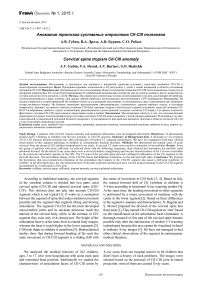Cervical spine tropism CII-CIII anomaly
Автор: Gubin Aleksandr Vadimovich, Drozd Vadim Anatolevich, Burtsev Aleksandr Vladimirovich, Riabykh Sergei Olegovich
Журнал: Гений ортопедии @geniy-ortopedii
Рубрика: Оригинальные статьи
Статья в выпуске: 1, 2015 года.
Бесплатный доступ
Study Design. 3 patients with CII-CIII tropism anomaly and unilateral subluxation were investigated and treated. Objectives. To demonstrate clinical and CT findings in children with the new anomaly in CII-CIII junction. Summary of Background data. A thorough in vivo research of CII-CIII junction became possible only after introduction of modern CT scanning technologies. We have not managed to find other clinical observations of this segment pathology in children in contemporary medical literature. Methods. We determined not typical cases of acute wryneck from the group of 262 children hospitalized in our clinic. X-ray and CT scans were used for evaluation of the problem. Results. From the group of patients with acute stiff-neck we selected three with the following symptoms: neck blocked and movement not possible; head advanced forward. On the lateral X-ray scans there were a cervical lordosis straightening and the pars interarticulares of the CII were overridden by the processus articularis superior of the CIII. The CT-scan of the cervical spine showed a unilateral subluxation of the CII segment in the forward direction. The articulation planes of the CII-CIII facets had different orientation on the left and right sides. Conclusion. We propose the hypothesis that non-symmetrical orientation of the articulation facet planes in the CII-CIII segment can cause a stiff-neck syndrome in children. In the described cases, the sole detected source of the pain syndrome and blocked neck was the tropism anomaly in the CII-CIII segment accompanied by a subluxation of the joint.
Children, cervical spine, tropism anomaly, cervical unilateral subluxation, stiff-neck
Короткий адрес: https://sciup.org/142134602
IDR: 142134602
Список литературы Cervical spine tropism CII-CIII anomaly
- Bogduk N., Mercer S. Biomechanics of the cervical spine. I: Normal kinematics//Clin. Biomech. (Bristol, Avon). 2000. Vol. 15, No 9. P. 633-648.
- Penning L. Differences in anatomy, motion, development and aging of the upper and lower cervical disk segments//Clin. Biomech. (Bristol, Avon). 1988. Vol. 3, No 1. P. 37-47.
- Swischuk L.E., Swischuk P.N., John S.D. Wedging of C-3 in infants and children: usually a normal finding and not a fracture//Radiology. 1993. Vol. 188, No 2. P. 523-526.
- Pediatric cervical spine: normal anatomy, variants, and trauma/E.S. Lustrin, S.P. Karakas, A.O. Ortiz, J. Cinnamon, M. Castillo, K. Vaheesan, J.H. Brown, A.S. Diamond, K. Black, S. Singh//Radiographics. 2003. Vol. 23, No 3. P. 539-560.
- Onan O.A., Hipp J.A., Heggeness M.H. Use of computed tomography image processing for mapping of human cervical facet surface geometry//Med. Eng. Phys. 1998. Vol. 20, No 1. P. 77-81.
- Beyer C.A., Cabanela M.E., Berquist T.H. Unilateral facet dislocations and fracture-dislocations of the cervical spine//J. Bone Joint Surg. Br. 1991. Vol. 73, No.6. P. 977-981.
- Braakman R., Vinken P.J. Unilateral facet interlocking in the lower cervical spine//J. Bone Joint Surg. Br. 1967. Vol. 49, No 2. P. 249-257.
- Unilateral cervical facet dislocation: injury mechanism and biomechanical consequences/N.R. Crawford, N. Duggal, R.H. Chamberlain, S.C. Park, V.K. Sonntag, C.A. Dickman//Spine. 2002. Vol. 27. No 17. P. 1858-1864.
- Ahmed A.M., Duncan N.A., Burke D.L. The effect of facet geometry on the axial torque-rotation response of lumbar motion segments//Spine. 1990. Vol.15, No 5. P. 391-401.
- Lee D.Y., Ahn Y., Lee S.H. The influence of facet tropism on herniation of the lumbar disc in adolescents and adults//J. Bone Joint Surg. Br. 2006. Vol. 88, No 4. P. 520-523.


